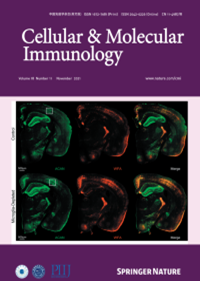Tumor cells that resist neutrophil anticancer cytotoxicity acquire a prometastatic and innate immune escape phenotype
IF 19.8
1区 医学
Q1 IMMUNOLOGY
引用次数: 0
Abstract
In the tumor host, neutrophils may exhibit protumor or antitumor activity. It is hypothesized that in response to host-derived or therapy-induced factors, neutrophils adopt diverse functional states to ultimately execute these differential functions. Here, we provide an alternative scenario in which the response of an individual tumor cell population determines the overall protumor versus antitumor outcome of neutrophil‒tumor interactions. Experimentally, we show that human neutrophils, which are sequentially stimulated with bacteria and secreted factors from tumor cells, kill a certain proportion of tumor target cells. However, the majority of the tumor cells remained resistant to this neutrophil-mediated killing and underwent a functional, phenotypic and transcriptomic switch that was reminiscent of partial epithelial‒to-mesenchymal transition. This cell biological switch was associated with physical escape from NK-mediated killing and resulted in enhanced metastasis to the lymph nodes in a preclinical orthotopic mouse model. Mechanistically, we identified the antimicrobial neutrophil granule proteins neutrophil elastase (NE) and matrix metalloprotease-9 (MMP-9) as the molecular mediators of this functional switch. We validated these data in patients with head and neck cancer and identified bacterially colonized intratumoral niches that were enriched for mesenchymal tumor cells and neutrophils expressing NE and MMP-9. Our data reveal the parallel execution of tumor cytotoxic and prometastatic activity by activated neutrophils and identify NE and MMP-9 as mediators of lymph node metastasis. The identified mechanism explains the functional dichotomy of tumor-associated neutrophils at the level of the tumor target cell response and has implications for superinfected cancers and the dysbiotic tumor microenvironment.

抗中性粒细胞抗癌细胞毒性的肿瘤细胞获得前转移和先天免疫逃逸表型。
在肿瘤宿主中,中性粒细胞可能表现出肿瘤活性或抗肿瘤活性。据推测,在对宿主源性或治疗诱导因子的反应中,中性粒细胞采取不同的功能状态来最终执行这些差异功能。在这里,我们提供了一种替代方案,其中单个肿瘤细胞群的反应决定了中性粒细胞-肿瘤相互作用的总体肿瘤与抗肿瘤结果。实验表明,在细菌和肿瘤细胞分泌因子的依次刺激下,人中性粒细胞杀死了一定比例的肿瘤靶细胞。然而,大多数肿瘤细胞仍然抵抗这种中性粒细胞介导的杀伤,并经历了功能、表型和转录组转换,这让人想起部分上皮细胞到间质细胞的转变。在临床前原位小鼠模型中,这种细胞生物学开关与nk介导的杀伤的物理逃逸有关,并导致淋巴结转移增强。在机制上,我们鉴定了抗菌中性粒细胞颗粒蛋白中性粒细胞弹性蛋白酶(neutropl elastase, NE)和基质金属蛋白酶-9 (matrix metalloprotease-9, MMP-9)作为这种功能开关的分子介质。我们在头颈癌患者中验证了这些数据,并确定了细菌定植的肿瘤内壁龛,这些壁龛富含表达NE和MMP-9的间充质肿瘤细胞和中性粒细胞。我们的数据揭示了活化的中性粒细胞并行执行肿瘤细胞毒性和前转移活性,并确定NE和MMP-9是淋巴结转移的介质。已确定的机制解释了肿瘤相关中性粒细胞在肿瘤靶细胞反应水平上的功能二分法,并对超感染癌症和恶性肿瘤微环境有影响。
本文章由计算机程序翻译,如有差异,请以英文原文为准。
求助全文
约1分钟内获得全文
求助全文
来源期刊
CiteScore
31.20
自引率
1.20%
发文量
903
审稿时长
1 months
期刊介绍:
Cellular & Molecular Immunology, a monthly journal from the Chinese Society of Immunology and the University of Science and Technology of China, serves as a comprehensive platform covering both basic immunology research and clinical applications. The journal publishes a variety of article types, including Articles, Review Articles, Mini Reviews, and Short Communications, focusing on diverse aspects of cellular and molecular immunology.

 求助内容:
求助内容: 应助结果提醒方式:
应助结果提醒方式:


